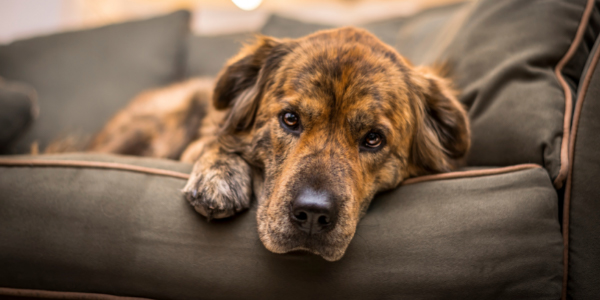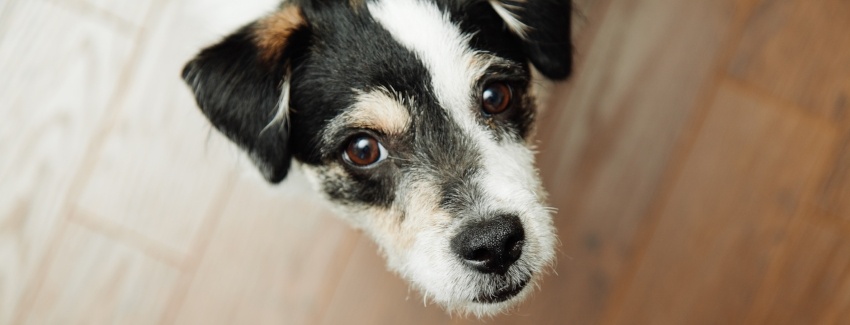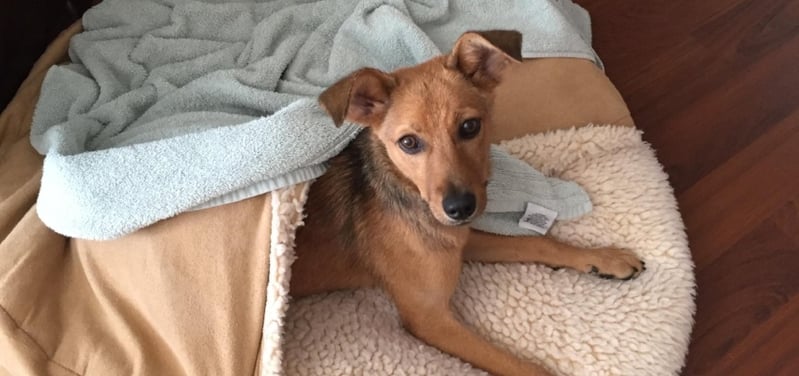 Bringing home a dog is an exciting time for everyone involved. However, while you get to return to the comfort of your home, your new puppy or adopted dog might not initially feel the same comfort. They’re in an unfamiliar environment with new people, new smells, and a new routine.
Bringing home a dog is an exciting time for everyone involved. However, while you get to return to the comfort of your home, your new puppy or adopted dog might not initially feel the same comfort. They’re in an unfamiliar environment with new people, new smells, and a new routine.
Whether they’re coming from a shelter or breeder, every dog will have a period of adjustment as they get used to their new home. Your dog’s behavior may be quieter than usual or feel "over the top." Some dogs deal with change by acting out while others shut down. Each dog works through their acclimation period at their own pace.
Don’t be discouraged and don’t take it personally if the first few days aren't what you expected. Simply be understanding and be there for them. With life having just been flipped upside-down, your new furry family member is depending on you to guide them through this transition period and establish comfort and confidence in their new life.
Whether they’re coming from a shelter or breeder, every dog will go through an initial adjustment period.
Prepare for Success: Before Bringing Your New Dog Home
Before bringing your new dog home, be mindful of the following details to make your home as calming and safe as possible.
- Set up soft, comfortable bedding in a crate or corner so your dog will have a cozy, safe place to retreat and relax. Oftentimes, dogs will choose their favorite spot where they feel safe. You may want to take note of this and put a comfy bed for them there. Read more in this article for more tips on how to create a safe space for your dog.
- Choose a designated area for food and water bowls.
- “Dog proof” by installing gates and picking up any potential hazards around your home.
- Toys can be a great way to provide entertainment and comfort. Pick out a variety of toy types so that your new pet will have options to pick his favorite.
Here’s some important information and advice on providing your new dog with safe chew toys. And don’t forget about interactive toys and puzzle feeders. These can be great to occupy time and provide some wonderful mental and physical exercise.
For a full list of my favorite products that can help your new dog adjust to your home, check out the New Puppy Checklist.

The Adjustment Period for Dogs: Rule of 3's
You're probably wondering how long does it take for a dog to adjust to their new home? Every dog is different, but there is a rule of thumb to keep in mind: 3 days, 3 weeks, 3 months.
- 3 Days: Initial transition. This time can be quite a shock to many dogs, especially puppies, as they have just left often the only home they've known and no longer have the constant companionship of their littermates or mother. Dogs adopted from a shelter or rescue need time to decompress from these often stressful environments.
Typically during the first few days in a new home, you'll see more shutdown behavior or caution at exploring new things. However, some dogs deal with stress differently and can have trouble settling down. - 3 Weeks: Middle transition. By around three weeks after arriving at their new home, most dogs are getting more comfortable with the routine and starting to show their normal behavior and temperament.
You may see a dog who was initially cautious and shy start to come out of their shell, perhaps exhibiting some training issues that you didn't notice the first few days. For other dogs, you may see them start to "chill out" as they continue to learn the house rules and thrive with routine and predictability. - 3 Months: End of transition. Usually by around three months after joining your family is when we anticipate a dog to be fully acclimated to their new environment and routine.
Depending on your dog's natural temperament, genetics, and history, they may take several days to several weeks before they feel comfortable and settled into your home. Dogs who have been rehomed multiple times may need longer, while puppies may breeze through this process quickly because they don't have previous negative experiences in their history. It’s important to be patient during this time and not ask too much of your pup.
Help Your New Dog Settle In
You can help ease the transition process by taking this time to bond with your new dog and allow them to adapt to their new home at their own pace. Have plenty of patience during this time, and simply make yourself available to your pup.
- Start by establishing a daily routine so your dog can expect when to eat, go for walks, play, and relax.
- Set boundaries, whether it’s “no getting on the furniture” or “no begging for food,” and be consistent with them from the beginning.
- Reward your dog with praise and treats for positive behaviors and redirect undesirable behaviors, such as teaching your dog to sit instead of jump up on people.
- To help your dog gradually adjust to being home alone, practice leaving them alone in your home for short increments (a few minutes at a time).
- Provide lots of enrichment activities to help your new dog decompress and burn mental energy. Check out 3 Ways to Calm Down a Hyper or Anxious Dog.
- Though it is wise to take a few days off from work and other activities to help your dog adjust, it’s important to continue with your daily home activities, so they can get used to the sounds, routine, and other things that happen day-to-day.
Watch for Signs of Stress
- Hiding or attempts to run away
- Separation anxiety, such as destructive chewing, scratching, or barking
- Refusal to eat or tummy troubles, such as diarrhea
- Potty accidents, even if your dog came to you house-trained
What NOT to Do When You Bring Your New Dog Home
While you and other members of the household are bonding with your new dog, there are a few activities that should be postponed until after your dog feels more comfortable.
Hold off on inviting all of your friends and family over at the same time to meet your new addition. Because your pup is already very stimulated by so many changes in their life, the presence of strangers vying for their attention will feel overwhelming and add to their stress.
Secondly, while you and your new pup should start to establish a relationship with your vet in the first week or so, I recommend waiting to take your dog to the groomer or dog daycare. Allow your new dog to relax in their environment before shaking things up with another change of scenery.

Patience is Key When Bringing Home a New Dog
You can expect some distance and uncertainty from your new dog, and they may not want to play or cuddle right away, but don’t be discouraged. Take it slow! You'll find that by giving a shy dog space and choices, they'll start to grow more confident in seeking out interactions. In time, your dog will warm up and let their unique character shine. Simply provide your love, support, and guidance (training), and they will soon realize that they really have found their “forever home.”
For young puppies or energetic dogs, patience is also important! They're still learning how to live in this human world of ours, so being clear and consistent with boundaries, management, and positive reinforcement training will be crucial for preventing long-term training or behavior issues. Connecting with a certified dog trainer can be a game changer to help set everyone up for success.
Staff Story: Bringing Kaya Home
This story is from a Preventive Vet contributor, Stacy Painter, about adopting her dog Kaya:
"Recently I brought home a 5-month-old rescue pup who was flown over from Taiwan. Having likely spent her first crucial weeks of life on the streets, she was very nervous and skittish around people, so I knew that we’d have to be very patient during her adjustment period and not expect too much from her too soon.
I gave Kaya lots of toys and treats to make my home feel fun and welcoming to her. On separate occasions, we invited my in-laws and my sister to come over and sit on the floor so she could get used to a few different people. While we are still working on her 'skittishness' around people, she has grown leaps and bounds, and her confidence shines when she chases a ball or gets puppy zoomies around the apartment."

One of Kaya's favorite comfy spots
Wondering whether your puppy is settling in at the right pace?
Want to learn how to help your dog acclimate and introduce them to the big, wide world?
Get help with your puppy's socialization plan in our Puppy Essentials: Socialization Foundations Workshop
Includes self-paced training modules, videos of puppy-safe socialization activities, and more — all for only $9!




